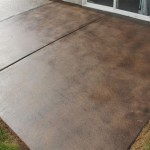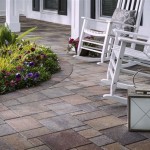How To Clean Up Old Concrete Patio Slabs In Florida, USA
Concrete patios, a common feature in Florida homes, provide valuable outdoor living space. However, the humid subtropical climate and exposure to the elements can lead to a buildup of dirt, algae, mold, and mildew on concrete patio slabs. This can result in an unsightly appearance and even pose a safety hazard due to slippery surfaces. Regular cleaning and maintenance are essential to preserving the functionality and aesthetics of a concrete patio in Florida. This article details the steps involved in cleaning old concrete patio slabs effectively.
Assessing the Condition of the Concrete
Before initiating any cleaning process, a thorough assessment of the concrete's condition is crucial. This involves identifying the types of stains present and evaluating the overall structural integrity of the patio. Common issues encountered include surface dirt, organic growth (algae, mold, mildew), rust stains, oil stains, and cracking or chipping of the concrete itself. Understanding the specific challenges will guide the selection of appropriate cleaning methods and materials.
Examine the concrete surface closely. Look for discoloration, dark spots, or areas where organic growth is particularly prevalent. Check for any signs of cracking, spalling (flaking), or uneven settling of the slabs. Note any existing repairs or patches, as these areas may require special attention during the cleaning process. This initial assessment will inform the subsequent steps and help determine the necessary level of cleaning intensity.
The type of stain or contaminant will influence the choice of cleaning agents. Algae and mildew thrive in humid environments and often appear as green or black patches. Rust stains, commonly caused by metal objects left on the patio, present as reddish-brown discolorations. Oil stains from vehicles or grilling can penetrate the concrete and require specialized degreasing agents. Identifying these stain types accurately is vital for selecting the most effective cleaning solution.
Gathering Necessary Materials and Equipment
Once the condition of the concrete has been assessed and the types of stains identified, assemble the necessary materials and equipment. This typically includes a stiff-bristled brush (preferably with a long handle for ease of use), a garden hose with a spray nozzle, a pressure washer (optional but highly recommended), appropriate cleaning solutions, safety goggles, gloves, and a bucket.
The choice of cleaning solutions depends on the identified stains and the user's preference for chemical versus environmentally friendly options. For general cleaning, a mixture of water and mild dish soap or laundry detergent can be effective. For more stubborn stains, commercial concrete cleaners, oxygen bleach, or trisodium phosphate (TSP) may be required. When using chemical cleaning agents, it is imperative to follow the manufacturer's instructions carefully and to wear appropriate personal protective equipment (PPE), including safety goggles and gloves.
A pressure washer can significantly reduce the time and effort required to clean a concrete patio. However, it is essential to use it cautiously and to select an appropriate nozzle and pressure setting. High pressure can damage the concrete surface, particularly if it is old or weakened. A wider fan nozzle and moderate pressure are generally recommended to avoid etching or scarring the concrete. If a pressure washer is not available, a garden hose with a spray nozzle and vigorous scrubbing can still achieve satisfactory results, although it will require more physical exertion.
Consider also having a putty knife or scraper on hand for removing any loose debris, dried leaves, or other surface contaminants before beginning the cleaning process. A broom can be used to sweep away loose dirt and dust. Having all the necessary materials and equipment readily available will streamline the cleaning process and ensure a more efficient and effective outcome.
The Cleaning Process: Step-by-Step Instructions
With the assessment complete and materials gathered, the cleaning process can begin. The following steps outline a systematic approach to cleaning old concrete patio slabs in Florida:
1.
Preparation:
Remove all furniture, plants, and other items from the patio area. Sweep away any loose debris, leaves, or dirt from the concrete surface. Cover any nearby plants or delicate surfaces that could be affected by the cleaning solution.2.
Pre-Soaking:
Wet the entire concrete surface with water from a garden hose. This helps to loosen surface dirt and also prevents the cleaning solution from drying too quickly, which can reduce its effectiveness. The pre-soaking step is particularly important in Florida's warm climate, where rapid evaporation can be a concern.3.
Applying the Cleaning Solution:
Depending on the type of stain and the chosen cleaning solution, apply the solution to the concrete surface. For general cleaning with dish soap or laundry detergent, mix the soap with water in a bucket and apply the solution evenly over the patio using a stiff-bristled brush or a garden sprayer. For more stubborn stains, apply specialized concrete cleaners or oxygen bleach according to the manufacturer's instructions. When using TSP, be aware of its potential environmental impact and follow local regulations regarding disposal.4.
Scrubbing:
Using a stiff-bristled brush, vigorously scrub the concrete surface to dislodge dirt, algae, mold, and mildew. Pay particular attention to areas with heavy staining or organic growth. If using a pressure washer, maintain a safe distance from the concrete surface and use a wide fan nozzle to avoid damaging the concrete. Work in overlapping strokes to ensure even cleaning. If scrubbing manually, a long-handled brush will help reduce strain on the back and knees.5.
Rinsing:
After scrubbing, thoroughly rinse the concrete surface with clean water from a garden hose. Ensure that all traces of the cleaning solution are removed. If using a pressure washer, use a moderate pressure setting to rinse away the loosened dirt and debris. Proper rinsing is essential to prevent residue buildup, which can attract more dirt and promote the growth of algae and mildew.6.
Addressing Stubborn Stains:
If some stains persist after the initial cleaning, repeat the application of the cleaning solution specifically to those areas. Allow the solution to dwell on the stain for a longer period before scrubbing and rinsing. For rust stains, a commercial rust remover or a mixture of lemon juice and salt can be effective. For oil stains, a degreasing agent specifically designed for concrete may be required.7.
Drying:
Allow the concrete patio to air dry completely before replacing furniture or allowing traffic. This will prevent tracking dirt onto the clean surface and allow the concrete to fully cure after cleaning. In Florida's humid climate, drying times may be longer, so it is advisable to allow ample time for the patio to dry thoroughly.Following these steps will effectively clean old concrete patio slabs and restore their appearance. Regular cleaning and maintenance will help to prevent the buildup of dirt and organic growth, extending the lifespan of the patio and maintaining its aesthetic appeal. Consider applying a concrete sealer after cleaning to protect the surface from future staining and weathering. This sealant will create a barrier that repels water and oil, making future cleaning easier and preventing the penetration of stains.

Best Way To Clean A Concrete Patio Chalking Up Success

How To Clean Old Concrete Patio Slabs

How To Clean Old Concrete Patio Slabs

How To Clean Old Concrete Patio Slabs

How To Clean Old Concrete Patio Slabs

How To Clean Patio Pavers For A Stunning Stone Epic Stoneworks

Mold On Pavers Battling Mother Nature Gothicstone

5 Ways To Fix Ed Or Damaged Concrete Patio Cricket Pavers

How To Clean A Concrete Or Cement Patio With Bleach Clorox

Concrete Patching How To Bond Existing For Best Results Sakrete
Related Posts








